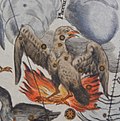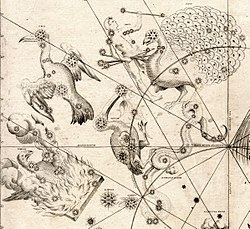Phoenix (constellation)
Phoenix (pronounced /ˈfiːnɪks/) is a small and not-so-bright constellation in the southern sky. It is one of the birds in a "nest" of bird constellations near it. This constellation was named after the mythical phoenix.
 Click for larger image | |
| List of stars in Phoenix | |
| Abbreviation: | Phe |
| Genitive: | Phoenicis |
| Symbology: | the Phoenix |
| Right ascension: | 0 h |
| Declination: | −50° |
| Area: | 469 sq. deg. (37th) |
| Main stars: | 4 |
| Bayer/Flamsteed stars: | 25 |
| Stars known to have planets: | 3 |
| Bright stars: | 1 |
| Nearby stars: | 2 |
| Brightest star: | α Phoenicis (Ankaa) (2.39m) |
| Nearest star: | ν Phoenicis (49.1 ly) |
| Messier objects: | 0 |
| Meteor showers: | Phoenicids |
| Bordering constellations: | Sculptor Grus Tucana Hydrus (corner) Eridanus Fornax |
| Visible at latitudes between +32° and −90° Best visible at 21:00 (9 p.m.) during the month of November | |
Mythology
This constellation represents a mythological bird that burns itself up every several hundred years then comes back alive from the ashes of the fire
Phoenix (constellation) Media
The constellation Phoenix as depicted in Johann Gabriel Doppelmayr's Atlas Coelestis, ca. 1742
The "southern birds", as depicted in Johann Bayer's Uranometria. Phoenix is on the lower left.
Other websites
| Wikimedia Commons has media related to Lua error in Module:Commons_link at line 62: attempt to index field 'wikibase' (a nil value).. |


